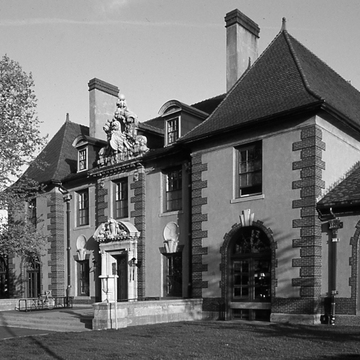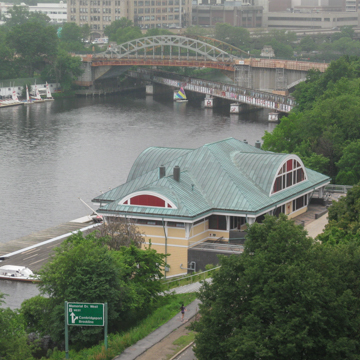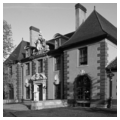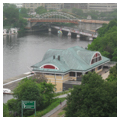Rowing has been identified with the Charles River since the mid-nineteenth century; the annual Head of the Charles Regatta, begun in 1965, is said to be the largest rowing competition in the world. Harvard College and Thomas Brattle constructed the first boathouse in 1800. Harvard students financed a new boathouse in 1856. Workers from the
Six boathouses of strikingly different character line the wide expanse of the lower Basin. The most recent is Boston University's De Wolfe Boathouse (1999, Architectural Resources Cambridge, 619 Memorial Drive), a yellow-shingled building with white and red trim that is reminiscent of the earlier boathouse on this site, built by the Boston Athletic Association in 1913 and leased to MIT for more than fifty years. Befitting its focus on technology, MIT commissioned Anderson, Beckwith and Haible to design the Pierce Boathouse (1965–1966, 409 Memorial Drive), a simple, wooden, modern building with flat roof and gray walls, a striking contrast to the classical limestone design of the MIT Sailing Pavilion just downstream (1936, Coolidge and Carlson, NRD). The smallest boathouse on the river is the Harvard Sailing Pavilion (1971, Shepley, Bulfinch, Richardson and Abbott), another flat-roofed wooden structure near the edge of the MIT campus. Near the Hatch Shell on the Boston side are the Union Boathouse (1910, Walter P. Henderson and Parker, Thomas and Rice, 144 Chestnut Street), a brown brick with cast stone trim classical revival building long separated from the river by the construction of Storrow Drive and the Storrow Esplanade, and the home of Community Boating (1940–1941, Kilham, Hopkins and Greeley; 1984 addition, 21 David Mugar Way), a horizontally striped gray brick building with a frieze of sailboats in stone. All of these buildings incorporate bays for boat storage, locker rooms, and weight rooms.


















